Street Music
It could be any summer afternoon – in fact it is every summer afternoon, just about lunchtime, when it starts. The morning street, empty and fresh, fills up with people. The locals, shoppers and tourists mix together and the neighborhood comes alive. In our garret apartment there is a gentle buzz from below: 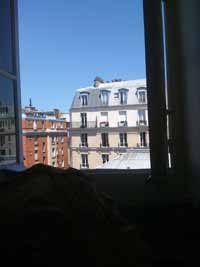 the background hum of people talking and laughing and the sounds of glasses and cutlery in use at the restaurant terrace beneath our windows. An occasional motorcycle or impatient car horn breaks the white noise. Otherwise, we cease to hear it.
the background hum of people talking and laughing and the sounds of glasses and cutlery in use at the restaurant terrace beneath our windows. An occasional motorcycle or impatient car horn breaks the white noise. Otherwise, we cease to hear it.
Until it starts: the squawking tones of an alto saxophone in the hands of a not-so-polished street musician. The moment I hear the first notes of Bésame Mucho I groan. A beautiful Mexican love song, written by a young woman who claimed never to have kissed anyone before writing it, I used to love this song, especially the Beatles’ version. Now it grates on me.
His playlist is limited and predictable. Bésame Mucho is always followed by the same bleak song, a bad rendition of a brooding melody reminiscent of old eastern Europe. Once heard, the tune remains fixed in my head for the rest of the day. Equally annoying: its title escapes me. I’m left humming the song to myself, then wondering, what is the name of this damn song?
~ ~ ~
Paris offers a menu of street music to satisfy anyone, especially tourists. The locals are too busy getting somewhere; we skirt around the upturned hat filled with suggestive coins. One avoids, if possible, those places where the cacophony of competing musicians and encircling crowds impede swift passage. The streets beside the Pompidou Centre, for instance, and the Pont Saint-Louis, the bridge spanning from Île St. Louis to Île de la Cité with its view of the Seine and Notre Dame‘s flying buttresses, these are prime locations to circumvent if you’re in a hurry or not in the mood for live music.
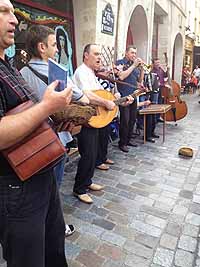
An unregulated métier such as this attracts a broad range of talent, from established orchestral groups with CDs for sale to a soloist accompanying music from a portable boom box by playing only the tambourine. In the summer it becomes so commonplace to see a musician or an ensemble set up on the street that it’s easy to ignore them, though harder to evade the crowd they might attract. Occasionally, though, there’s a gem. An accomplished violinist stands under the arches of the arcades surrounding Place des Vosges, her concerto echoes hauntingly and any passerby is compelled to stop and listen and watch her sway back and forth as she plays. An acoustic guitarist sits in a shaded doorway strumming you back to your best childhood memories.
Buddy-roo likes the guitarists the best, and has befriended several, somehow managing to win their favor and on occasion, finagle a free CD. She knows I’m a sucker for a good musician, so as we approach one she’ll turn to gauge my reaction. If the music makes me smile, she’ll beg me for a coin, and run over to put it in whatever basket or hat has been laid out to receive such appreciative donations. Sometimes we’ll linger, getting our money’s worth. Buddy-roo will sway beside me, or do a little dance if she’s feeling inspired.
“How do you decide which ones to give money to?” Short-pants once asked. She knows I struggle with whether or not to give money to people on the 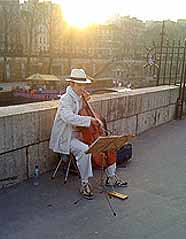 street. If I do, it’s usually to street musicians. Among these performers I have standards: some measure of talent, authenticity, and stage presence will motivate me to open my change purse.
street. If I do, it’s usually to street musicians. Among these performers I have standards: some measure of talent, authenticity, and stage presence will motivate me to open my change purse.
“The ones whose music moves me the most,” I told her, “and the ones who seem really dedicated, who work the hardest.”
“Do you think I could make money playing my viola in the street?”
“Only if you keep practicing.”
~ ~ ~
It was almost eight years ago, when every morning and night for six weeks straight, De-facto and I traipsed across the Pont Saint-Louis on our way to and from the metro that took us to the children’s hospital, where we’d sit beside Short-pants for hours, waiting and watching for one of her doctors to come by and answer our questions. Each night on the way home, I’d call my brother, a doctor, to report the medical updates and he’d put them in layman’s terms for us. Once, he was describing the difference between meningitis and encephalitis, his explanation barely audible over an accordion playing La Vie en Rose.
My brother, hearing the music, stopped. “This is too surreal,” he said.
“Yeah,” I said, “but it’s also my sanity.”
The accordion player was there on that bridge nearly every morning and almost every night. It was December, cold and windy. And it was dark, not like the summer when daylight stretches way behind the dinner hour and crowds congregate on that same bridge eating ice-cream and watching street performers. Some nights we were the only people in sight, passing him on the bridge as his keypad swelled in and out, like it was breathing. Any coins I had in my pocket were left in the basket beside him, his earnest and constant commitment inspired my own; his music, as schmaltzy as it was, gave me hope for her recovery.
~ ~ ~
On rue Charlot, a small storefront window displays reed instruments of every type: clarinets, oboes, saxophones and other members of the woodwind family, and some flutes for good measure. The proprietor is a gentle-souled, soft-spoken man with a long face, appropriately solemn to suit the tone of the instruments he tends. I pass by often and I rarely see customers in the store, but he’s always there, diligently repairing the pads of an aging oboe or restoring the glory to an antique silver flute.
Short-pants and I walked by the other day, as he was removing the shutters from the window to open the shop. I told her I wanted to stop at the store to talk to him. He corrected me, in English. “Not a store, it’s a workshop.”
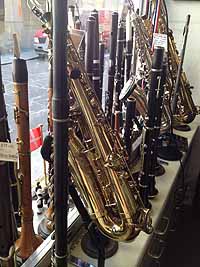
It is a workshop. Not only is the front window packed with instruments he’s repaired and refurbished for resale, there is every kind of saxophone hanging from the ceiling against every wall. Machines with clamps and fan-belts from the mid-twentieth century collect dust. Canisters of tools – some of them resembling those of a dentist – sit atop every workspace. The clutter of instruments, equipment, antique metronomes and loose sheet music is covered with a fine layer of dust. It is part factory, part studio, part museum.
We’d just come from a café up the street. A musician there, this one a trumpeter – or trying to be – had taken it upon himself to entertain the customers on its terrace. He had a little boom box with him, providing a cheesy synthesizer accompaniment. The last song he played before he was shooed away by our annoyed waiter was the very same haunting tune the alto-saxophonist beneath my window always plays after Bésame Mucho, the ear worm I can’t name.
I stepped inside the woodwind workshop, cleared my throat and hummed the melody to the craftsmen. I asked him if he knew the title.
Right away he nodded. “Shostakovich, the second waltz.”
I knew he’d know it. I thanked him profusely for answering the riddle that had been plaguing me, and quietly left a two-euro coin on his desk before slipping out the door. I hummed that waltz all the way home. It sounded different when hummed through a smiling mouth, not as melancholy – it was nearly triumphant.

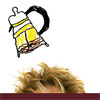
August 19th, 2012 at 12:46 pm
Have you ever been in the music shop on Calle Zapateria? Exact same description as your Paris music workshop. (I think all *real* music shops are like this)
I use to fiesta street music for that calming affect. What you need is to import some fiesta txaranga bands.
Let them battle it out with the useless organ grinders. The survival of the most musical.
August 19th, 2012 at 3:45 pm
This post is a poem 🙂
August 19th, 2012 at 4:04 pm
Thank you so much for the link to the waltz! Unlike you in Paris with too much street music, we Bostonians have not enough, with the exception of a particularly bad saxophonist and countless drummers on plastic buckets. I especially love the large troop of men singing and playing violins in, I think, Chatelet. It always makes me well up. Thank you for your lovely tales of life in Paris.
August 19th, 2012 at 9:09 pm
[…] >more […]
August 20th, 2012 at 8:12 am
When I lived in East Harlem, I grew accustomed to the tunes that drifted through my morning window each Saturday from the jovial local “quartet” that occupied my apartment stoop weekly. This ensemble always consisted of at least one guitar, one mini battery-powered piano (strapped around the neck), one harmonica, and a vocalist who alternated his traditional Puerto Rican songs with sips of 9am Corona. In place of the synthesizer boom-box, if I was lucky, they’d pull up their pick-up truck and blast accompaniment from the stereo. Regardless of the mornings I was wishing I had just one more hour of silence through my hang-over fog, it is also one of my favorite memories of Harlem living. Perhaps retrospect has turned this memory rose-colored.